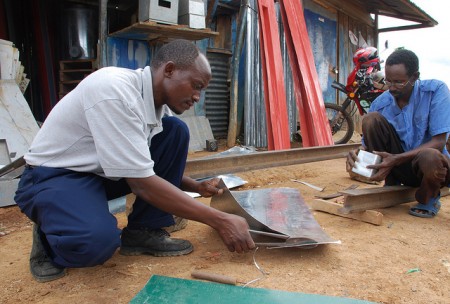
Drought forces thousands of people to cross the border from Somalia to Kenya every day. Violence erupts in a refugee camp in Ethiopia due to insufficient shelter. Rebel groups evict people from their homes. Insufficient water supply causes death and illness. Children turn to painting to depict the trauma caused by the massacres which they have witnessed.
The Annual Conference of the Humanitarian Aid held in Basel on 23 March 2012 addressed these issues under the motto “sharing responsibility” and explored how Switzerland can help to relieve people from such suffering.
This cannot be achieved through ad-hoc projects. There needs to be a framework, expertise and extensive coordination. The conference kicked off with the Swiss Minister for Foreign Affairs, Didier Burkhalter, who discussed the principles of universality, rule of law, neutrality, solidarity and responsibility on which Swiss humanitarian aid is based.
Following on from this theoretical introduction, the conference became more practically oriented. Concrete examples of shared responsibility between Switzerland and other actors were presented, such as the response to the emergency in the Horn of Africa.
Horn of Africa
The United Nations High Commissioner for Refugees (UNHCR), António Guterres, discussed the protection of refugees in the Horn of Africa. Over 7 million refugees – nearly the whole population of Switzerland – live in exile without any prospects and over 800,000 of them will need to be resettled. Efforts to protect these people require huge resources and effective cooperation. Guterres urged countries to guarantee quality procedures, such as access to legal services. He also called for the adoption of a pan-European asylum policy. He pointed out that Switzerland could provide valuable support by employing its expertise in emergency situations and by providing greater funding.
Although the challenge remains immense, some progress has been achieved. One short video depicted a success story. It started with 150,000 people, whose flight from drought and famine in Somalia led them to a refugee camp on the border between Somalia, Ethiopia and Kenya. Martin Zirn, an expert from the Swiss Humanitarian Aid Unit and a shelter planner at the UNHCR, improved the conditions in the refugee camp by renovating shelters, building solid roads, providing a guaranteed supply of quality water and improving the standards of hygiene.
Nevertheless, a cynic would argue that this modest progress represents little more than a drop in the ocean. In a country like Somalia, where two-fifths of the population needs assistance, far more expertise and advocacy is needed to convince the international community to provide more help.
Colombia
At the end of 2010, Colombia (along with Sudan) had by far the largest populations of internally displaced persons (IDPs) in the world. These IDPs have been forced to flee the civil war that has gripped the country for almost 50 years now. A short video clip shown at the conference illustrated the dire implications of displacement. It told the story of IDPs driven to abandon their homes and live in villages built on piles of rubbish. In stark contrast to many others, this story had a happy ending, largely due to the assistance provided by the Swiss Agency for Development and Cooperation (SDC).
The SDC describes its mission as two-fold: it provides humanitarian aid to enhance the quality of life of IDPs, and protects the victims of violence who face immense insecurity as a result of displacement. This insecurity may manifest itself in the form of suspicion against humanitarian workers and in certain situations may even lead to physical attacks. This issue has been addressed by partnering with organizations like Action Against Hunger (ACF), which are perceived to be neutral humanitarian actors.
Arab World
The diversity of the SDC was demonstrated by another video presentation, which outlined its activities in Tunisia in the aftermath of the uprising. In this case, the priority of Swiss humanitarian aid is to create jobs in the private sector. In collaboration with a local bank, interest-free loans are provided to selected companies. Other projects in the region aim to improve access to drinking water in rural areas and teach children how to use water sustainably.
Arts
To conclude the conference, the curator Dr. Ulf Küster illustrated — in a short, but impressive presentation — how art can help relieve the pain of people in a conflict. He argued that literature, music and painting can offer consolation, create identity and act as a memorial, like Picasso’s Guernica did for victims of the Spanish Civil War. Children in Darfur drew pictures of civilian shootings and other acts of violence that they had experienced as a form of “art therapy.” In the discussion which followed, the Director-General at the SDC, Mr. Dahinden, indicated that although he does not regard art therapy as a central pillar of humanitarian aid, he believes that it can be a supportive tool in certain situations and that the SDC ought to protect and restore cultural assets where possible. He disputed the validity of Abraham Maslow’s famous “hierarchy of needs,” which implies that art is not a basic human need. He argued, on the contrary, that even a society faced with conflict needs cultural assets to signify its history and identity.
For further information on the topic, check out the following articles:
Somalia and the Humanitarian Crisis in the Horn of Africa
Colombia’s Humanitarian Crisis
Finally, Religion in Conflict Transformation: Arts-based Approaches explains how conflicts can be addressed constructively by using arts.

